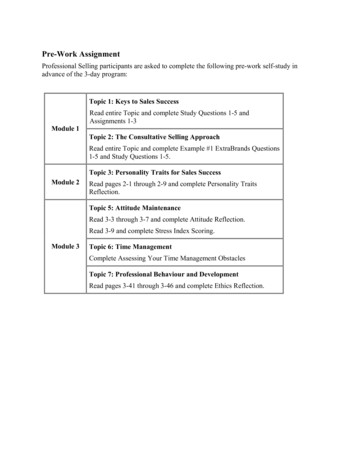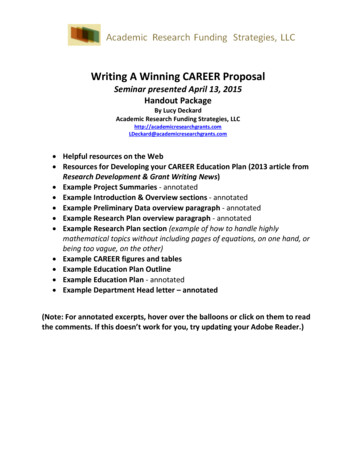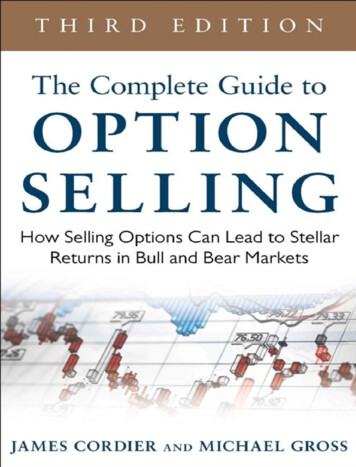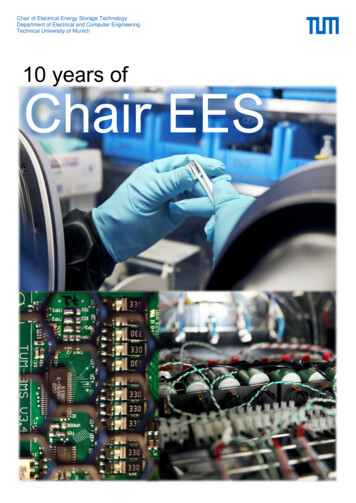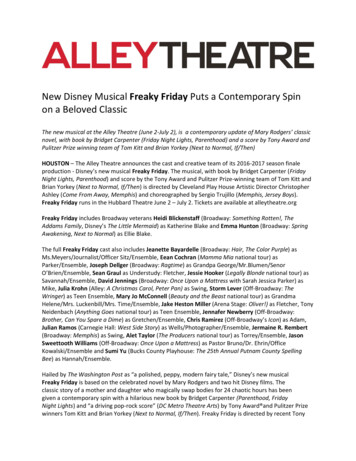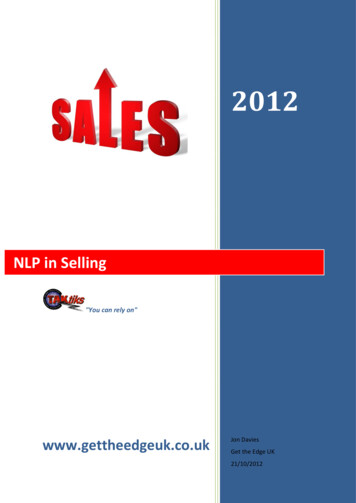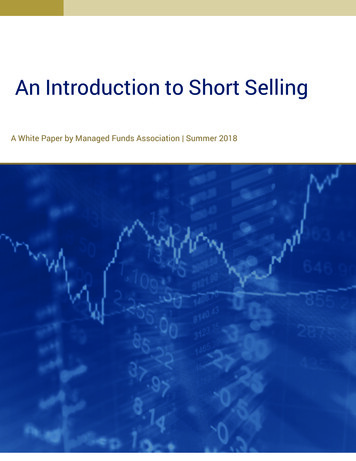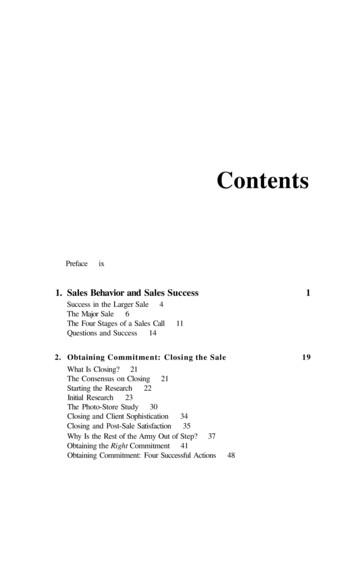
Transcription
ContentsPrefaceix1. Sales Behavior and Sales SuccessSuccess in the Larger Sale 4The Major Sale 6The Four Stages of a Sales CallQuestions and Success 141112. Obtaining Commitment: Closing the SaleWhat Is Closing? 21The Consensus on Closing 21Starting the Research 22Initial Research 23The Photo-Store Study 30Closing and Client Sophistication 34Closing and Post-Sale Satisfaction 35Why Is the Rest of the Army Out of Step? 37Obtaining the Right Commitment 41Obtaining Commitment: Four Successful Actions1948
ContentsCustomer Needs in the Major SaleDifferent Needs in Small Sales and LargeHow Needs Develop 55Implied and Explicit Needs 57Buying Signals in the Major Sale 625354The SPIN Strategy67Situation Questions 67Problem Questions 69Implication Questions 73Need-payoff Questions81The Difference between Implication and Need-payoff QuestionsBack to Open and Closed Questions 90The SPIN Model 91How to Use SPIN Questions 9488Giving Benefits in Major Sales99Features and Benefits: The Classic Ways to Demonstrate CapabilityThe Relative Impacts of Features, Advantages, and Benefits 106Selling New Products 111Demonstrating Capability Effectively11599Preventing ObjectionsFeatures and Price Concerns 119Advantages and Objections124Benefits and Support/Approval133117Preliminaries: Opening the Call137First Impressions 138Conventional Openings 139A Framework for Opening the Call143Turning Theory into PracticeThe Four Golden Rules for Learning Skills 148A Summary of the Call Stages 152A Strategy for Learning the SPIN Behaviors 155A Final Word 159147
ContentsviiAppendix A. Evaluating the SPIN Model161Correlations and Causes 163Is Proof Possible? 168Enter Motorola Canada173A New Evaluation Test 180Final Thoughts on Evaluation 186Appendix B. Closing-Attitude ScaleCalculate Your Score 191What Do the Scores Mean? 191Index193187
PrefaceThis is yet another book about how to sell more successfully. So whatmakes it different from the more than 1000 sales books alreadypublished? Two things:1. It's about the larger sale. Almost all existing books on selling haveused models and methods that were developed in low-value, one-callsales. In the 1920s, E. K. Strong carried out pioneering studies of smallsales that introduced such new ideas to selling as features and benefits,closing techniques, objection-handling methods, and open and closedquestions. For more than 60 years, these same concepts have beencopied, adapted, and refined with the assumption that they should applyto all sales. Even the few writers who have tried to give some advice onlarger sales have based many of their ideas on these older models. Andthat's a mistake, because the traditional strategies of how to sell just don'twork in the fast-moving and complex environment of today's major sale.This, I believe, is the first book to take a completely fresh look at largersales and the skills you need to make them succeed. As you'll see, manyof the things that help you in smaller sales will hurt your success as thesale grows larger. Major sales demand a new and different set of skills,and that's what this book is about.2. It's based on research. This is the first publication of results fromthe largest research project ever undertaken in the selling-skills area. Myteam at Huthwaite analyzed more than 35,000 sales calls, over a periodof 12 years, to provide the hard facts on successful selling that you'll readhere. There are plenty of opinions on how to sell, but a real shortage oflx
XPrefacewell-researched facts. I carried out the research described in this bookbecause I wasn't satisfied with opinions. I wanted proof. And now, after amillion dollars of research, I can give you well-documented evidenceabout how to be more successful in larger sales.I'm writing for those who are serious about selling—who see theirselling as a high-level profession needing all the skill and care that gowith professionalism in any field. And I'm writing about how to makemajor sales—that significant business which has the margins and rewards attractive to high-level sales professionals. In our studies we'veworked with top salespeople from more than 20 of the world's leadingsales organizations. From watching them in action during major sales,we've been able to find out what makes them so successful. That's thesubject of this book.But how do you know that the methods I'll be describing can help yoube more effective? I'm confident that they will, and my confidence isbased on something more substantial than just hope. When we firstdiscovered the methods described in this book, we weren't sure whetherthey would help people sell more effectively. For one thing, many of ourfindings were controversial and directly contradicted most existing salestraining; for another, we weren't sure whether the methods used bysuccessful professionals would be too difficult for most people to learn.So we kept quiet about our findings for 7 years, testing out thepractical value of our ideas before we were ready to publish them.During that time we trained several thousand salespeople in the methods we describe here, continuously experimenting to find the best way toturn our theoretical knowledge of sales success into simple and practicalmethods that could help anyone become more effective in major sales.We measured the productivity gains of the first thousand people wetrained, comparing them with control groups from the same companies.T h e people we'd trained showed an average increase in sales volume of17 percent more than the control groups. Consequently, I'm confidentthat this book gives well-tested methods for increasing sales results. It'salready helped thousands of people be more successful in largersales—and it can give the same help to you.More than 10,000 sales people in 23 countries generously agreed to letHuthwaite researchers travel with them and observe them in actionduring sales calls. This book is about them and for them with our thanks.Then I must thank upwards of 1000 sales managers who have been partof programs we've run across the world and who have helped refine theideas I'm presenting here.Finally, at last count, there were more than 100 people who wereclosely involved in the research itself and in the development of our
Prefacexiideas. I can't include them all, but special mention must go to PeterHoney and Rose Evison, who worked with us to develop the originalbehavior-analysis methodology we used in our research. From thismethodological base, we were able to produce some initial measurementinstruments that let us take the first-ever scientific, quantitative look atsales calls. In those early stages Roger Sugden deserves special mentionas the first member of the Huthwaite research team to use these earlymethods.For the development of the SPIN Model itself, thanks should go toSimon Bailey and Linda Marsh, who helped during the initial fieldstudies to validate the SPIN Model. Many other Huthwaite colleagueshave helped, including Dick Ruff and John Wilson, whose experience astrainers has given me valuable insights into how to express many of theconcepts I describe here. Also my thanks to Joan Costich, who helpedme revise the manuscript, and to Elaine Ailsworth, who prepared theillustrations.People outside Huthwaite who have made substantial contributionsinclude Masaaki Imai of the Cambridge Corporation, who has adaptedour models to fit the fascinating Japanese sales environment; Jan vanden Berg of McKinsey and Co., who has forced me to express theseconcepts in fewer words than I thought decent; and Harry Gaines,whose instincts for layout and presentation have changed the shape ofthe book.Neil Rackham
1Sales Behaviorand Sales SuccessThe V.P. of Sales met me at O'Hare airport and within minutes we weredriving through the Chicago suburbs. He wasted no time in gettingdown to business. "The reason I want you to do this research," he explained, "is because our sales are about 30 percent lower than theyshould be. As you know, we're a Fortune 100 company and we invest alot in recruiting and training. Yet I'm not getting the results I'm lookingfor. I want your research people to travel with some of my sales repsand find out what's wrong."This was a perfect opportunity. My organization, Huthwaite, hadbeen working for several years to develop a method called behavioranalysis, which allowed us to watch salespeople at work and to figureout which of the sales behaviors they used were the ones most linked tosuccess. I jumped at the chance to try our new methods. Using our research team and some managers from the V.P.'s oWn organization, wewent out in the field to watch how his people behaved in sales calls.Two months later we were ready to meet with him again to share ourfindings. In the meeting room, as I stood up to speak to the V.P. and hissales management team I knew he wouldn't like what we were about tosay. I decided to take him through the easy bits first,; so I said that we'dobserved 93 calls and that we'd been out with some of his best performers and with some who were—I searched for a delicate word—well, lessthan best."Yes," he said impatiently. "You don't have to remind me. What didyou find?"I answered cautiously. "Let's first discuss what's going on in the sucl
2Chapter Onecessful sales calls," I suggested, "and see what's different about them.We found.""Let me guess," he interrupted. "You went out with some of our superstars. I think I know what's different about their calls. They're goodclosers. Am I right?"I hesitated for a moment. "Not exactly," I answered, "at least not ifyou mean that they use a lot of closing techniques. In fact, in your successful calls we recorded a lot fewer closes than in the calls that failed.""I find that hard to believe," he protested. "What else did you find?"Before I could reply, a thought struck him. "I guess objection handlingcould be just as important as closing," he conceded. "Maybe my top people are better at overcoming objections."Something told me this was going to be a difficult meeting. "Uh,again, not exactly," I answered. "We found that your successful callscontained very few objections. In terms of objection-handling skills, Idon't think your top people were any better than your poorer people."That was clearly the wrong thing to say. One of the sales managerspresent helpfully tried to get the meeting back on track. "Why don't youtell us what you found about probing skills?" he suggested. "I think thatthis would be more useful."The V.P. brightened up noticeably. "Yes," he said, "probing skills arevery important. When I'm invited to address sales-training classes, I always stress how essential it is in selling to ask good questions. Lots ofopen questions—you know, the ones that can't be answered in oneword. I tell new people to avoid closed questions and concentrate onasking more of those open questions. I guess that's what you found mygood people were doing?"I was cornered and in trouble. With real desperation in my voice, Ireplied, "You're quite right that good probing skills are important. Butfrom watching your people sell, it doesn't seem to matter whether theirquestions are open or closed. In fact, your best people aren't any different from your worst in terms of how they use open and closed questions."The V.P. was indignant. "Are you serious?" he asked incredulously."Do you realize that you've just taken the three most important areas ofselling—closing, objection handling, and probing—and told me theydon't matter?" He looked around the table and asked, "Isn't that whatthis guy's saying?" There was an awkward silence. Finally one of his junior managers spoke, picking his words with care."If what he's saying is right," the junior manager began cautiously,"and I must emphasize if, then we've been wasting a whole lot of timeand money on our sales training. After all, that's exactly what we're
Sales Behavior and Sales Success3training people to do—to uncover needs with open and closed questions, to overcome objections, and to close for the business."The V.P. thought for a moment. "That's right," he said. "Those arethe three key things we teach our salespeople. And not only us—that'swhat other big corporations teach their people top." He searched hismemory. "That's what IBM teaches," he said. "GTE does, Xerox does,AT&T too.""And Honeywell, and Exxon," added one of his managers."I was in Kodak," said another, "and those were the three key thingsin their sales training."The V.P. turned to me. "I don't want to cast doubt on your researchability," he said, "and I thank you for your efforts. However, I'm sureyou'll understand that your findings go against our experience—andthe experience of other major corporations—so I've got to believe yourconclusions are wrong."That ended the meeting. As a young and little-known researcher, Ididn't have the firepower to challenge the sales-training wisdom of dieworld's leading companies. I licked my wounds during the flight home,and, being honest about it, had to admit that my evidence wasn't strongenough to be convincing. If I'd been in the V.P.'s shoes, I wouldn't havelistened either.Since that uncomfortable meeting, my colleagues and I have collectedmuch more compelling evidence. We've spent 10 years analyzing over35,000 sales transactions. We've studied 116 factors that might playsome part in sales performance, and we've researched effective sellingin 27 countries. Our studies constitute the largest-ever investigation intosales success. Now, having had the benefit of an additional million dollars of systematic research, we could give that V.P. some convincing answers. We could tell him, for example: His sales training was fine for low-value sales. What we had discovered was that the traditional selling mediods his people were usingceased to work as the sales grew larger. This was why his top people,who were making high-value sales, no longer relied on such techniques as objection handling and closing. We now know that there are much more effective techniques that successful people use in major sales. At the time we didn't understandthese methods well enough to describe them convincingly, but nowwe'd be able to tell the V.P. how his top people were using a powerfulprobing (or investigating) strategy called SPIN and that this, morethan any other selling skills, accounted for their success.
4Chapter OneWhat's more, we could also tell him something equally convincingabout the companies he listed who were teaching the traditional modelsof probing with open and closed questions, overcoming objections, andclosing. Although neither of us knew it at the time, many of these corporations were becoming distinctly unhappy about the usefulness ofthis traditional core of selling skills. More than two-thirds of the companies listed during the meeting have come to Huthwaite in the last 5years to ask us to redesign their major-account sales training. Based onour research into what makes success in the larger sale, we've helpedthem replace traditional models of how to sell with new and more powerful training.Success in the Larger SaleResearch has an inconvenient way of coming up with evidence that theresearchers sometimes wish they'd never found. That's what happenedto me. I was perfectly content with traditional theories of how to sell.When we started our investigations, our aim was to show that classicsales-training methods really worked and had a positive impact on salessuccess. It was only after we found a consistent failure of sales trainingto improve results in major sales that we began the long research roadthat led to the development of the methods described in this book. Before our research, I was happy to think of selling in the traditional termsthat our findings now challenge. I was taught—and perhaps you weretaught this too—that a sales call consists of some simple and distinct steps:1. Opening the call. The classic theories of selling teach that the mosteffective method for opening sales calls is to find ways to relate to thebuyer's personal interests and to make initial benefit statements. Asdescribed in Chapter 7, our research shows that these opening methods may be effective in small sales but that they have a doubtful success record in larger sales.2. Investigating needs. Almost everybody who's been through salestraining in the last 60 years has been taught about open and closedquestions. These classic questioning methods may work in smallsales, but they certainly won't help you in bigger ones. Later in thischapter I'll introduce you to a more effective method of Investigating, which we discovered from the analysis of several thousand successful sales calls and from watching some of the world's top salespeople in action.
Sales Behavior and Sales SuccessGiving benefits. Once you've uncovered needs, traditional salestraining teaches you to give benefits that show how the features ofyour product or service can be used or can help the customer. Offering benefits in this way can be very successful in the small sale,but in the large one it fails entirely. Chapter 5 introduces a newtype of benefit that research shows is successful in large sales.Objection handling. You've probably been taught that overcomingobjections is a vital skill for sales success, and you'll know about thestandard objection-handling techniques, such as clarifying the objection and rewording it in a way you can meet. These objectionhandling skills are fine when you're making small sales, but in majorsales they contribute very little to your sales effectiveness. Successfulsellers concentrate on objection prevention, nou on objection handling; based on our analysis of how they do it, Chapter 6 describesmethods that you can use to cut the number of objections you getfrom your customers by more than half.Closing techniques. The closing techniques that can be effective insmaller accounts will actually lose you business as the sales growlarger. Most of the commonly taught closing techniques just don'twork for major sales. Chapter 2 describes effectivje ways of obtainingcustomer commitment in these sales.In summary, the traditional selling models, mjethods, and techniques that most of us have been trained to use work best in smallsales. For now, let me define small as a sale which can normally becompleted in a single call and which involves a low dollar value. Unfortunately, these tried-and-true low-value sales techniques—most ofthem dating from the 1920s—don't work today in complex highvalue sales. The problem with these techniques isn't ithat they are outdated; people wouldn't still be using them after 60 years unless theyhad something valid to offer. Their inadequacy, and my reason forthis book, is that these techniques work effectively only in very simplelow-value sales. Because most writers and training designers havemade the inaccurate assumption that what works in a small sale willautomatically work in a large one, people have unfortunately come toassume that these traditional techniques are equally valid in majorsales, but in this book I'll be showing you that what works in smallsales can hurt your success as the sales grow larger—and I'll be sharing with you our research findings that have uncovered new and better models for success in large sales.
6Chapter OneThe Major SaleI'm writing this book for people whose business is the major sale—andwho, like me, have become dissatisfied with the effectiveness of traditional sales models and are looking for something more sophisticated.Many of the major-account salespeople I work with complain that traditional sales training treats them as if they were selling used cars.What's worse, it treats their customers as simpletons waiting to be exploited by verbal trickery and manipulation. Programs of this kind, regrettably, are the rule in most organizations rather than the exception—and their recommendations are a recipe for disaster in major sales. Themain purpose of our research has been to replace these simplistic models with ones specially designed for the high-level business interactionthat major sales demand.There's been more written about the definition of major sales thanabout how to sell successfully once you've defined them. I'm not goingto bore you with definitions. I'm sure that whatever the term you use—whether you talk of major-account sales, big-ticket sales, system sales,large accounts, bulk sales, or just "the big ones"—you know a major salewhen you meet one.What I shall do is briefly run through some of the characteristics ofmajor sales in terms of customer psychology. It's the changes in customer perceptions and behavior that make major sales different. Let'slook at what some of these differences are and how they can affect yourselling.Length of Selling CycleWhereas a simple low-value sale can often be completed in one call, amajor sale may require many calls spread over a period of months. Oneof my former classmates selling in the aircraft industry once went 3years without making a single sale. On the face of it, it sounds like I'mjust making the obvious point that major sales take longer. But there'smore to it than this. What's really important is that multi-call sales havea completely different psychology from single-call sales. A key factor isthat in a single-call sale the buying decision is usually taken then andthere with the seller present, but in a multi-call sale the most importantdiscussions and deliberations go on when the seller isn't present, duringthe interval between calls.Just suppose I'm a brilliant orator who can give a truly compellingproduct pitch. I'm likely to do well in the single-call sale. This is because
the person I'm selling to can be sufficiently impressed by the excellenceof my pitch to say yes on the spot and give me an order. But what happens if it's a longer selling cycle, so that I don't tak; the order immediately after I've made my pitch? How much of what ] 've said will the customer remember tomorrow after I've gone? Could the customer repeatmy smoothly polished presentation to her boss?Questions like these prompted us to do a small study in an officeproducts company, where we found that less than half of the key pointsthe sellers covered in their product presentations were remembered bycustomers a week later. What's worse, customers who told us immediately after the presentation that they were likely to buy had lost most oftheir enthusiasm for the product within a week.A good product pitch can have a temporary effect on a customer, buta few days later it's largely gone. So if you can get a decision on thespot—as you usually can in a one-call sale—then there's no reason whyyou shouldn't use the temporary effect of a product pitch to raise customer enthusiasm and help you get the business im nediately. But woebetide you if you can't get an instant decision. By next week your customers will have forgotten most of what you've saic and will have losttheir enthusiasm for your product.Another of our findings, which we'll examine in much more detail inChapter 6, was that in the one-call sale you could sell by pushing yourproduct, overcoming any objections, and closing hard for the business—but that in a multi-call sale this style was usual ly dangerously unsuccessful. Why? Perhaps your own experience as a buyer gives the answer. I can remember, for example, going into a car showroom a fewmonths ago. The seller was one of those pushy types who overpopulatethe motor trade. After a couple of perfunctory questions, he gave me areally hard sell, using all the classic closes in the book. I wasn't ready todecide, so his pressure was both unwelcome and irritating. After I finally escaped, I made all sorts of solemn vows never to return to thatshowroom. I'm sure you've had the same kind of experience. Few customers will elect to go back for a repeat dose of pressure. In terms ofyour own selling, if you pressure a potential customer, then he or shewon't want to meet you again. The rule seems to be that it's OK to bepushy if you can take the order there and then, but once you and yourcustomer part company without an order, your pusliness has reducedyour chance of final success. And because the customer doesn't want totalk with you again, you may never discover where you went wrong. Sowhile a pushy or hard-sell style may work in smaller sales, it generallyacts against you when several calls are needed to take the business.
8Chapter OneSize of Customer's CommitmentAlmost by definition, large purchases involve bigger decisions from thecustomer, and this alters the psychology of the sale. In a small sale thecustomer is less conscious of value. As the size of the sale increases, successful salespeople must build up the perceived value of their productsor services. The building of perceived value is probably the single mostimportant selling skill in larger sales. We've studied it in detail, and several chapters of this book are devoted to how to increase the value ofwhat you offer your customers.Several years ago we started a study that, because of a reorganizationin our client's sales force, was never completed. This is a pity, because itwas all about how the need to sell value increases as the sale gets larger.The client, who sold high-cost products, had asked us to advise onwhether it was possible to recruit new salespeople whose only previousselling experience had been with cheaper goods. At the point where theproject was stopped, we were coming up with some interesting answers.We found that the salespeople who didn't successfully transfer to handling larger sales were those who had difficulty building the customer'sperception of value.I remember meeting one of these less successful people at the Buffaloairport before going out with him to make some calls. He was sitting ona bench with his briefcase open and was surrounded by enough productliterature to keep a paper-recycling factory in business for months. Heexplained, miserably, that he was learning product details because hethought it would help him be more successful. "In my last job," he explained, "I was selling consumer goods and it was my product knowledge that made all the difference." He may have been right, but it washis product knowledge that prevented him from being successful anhour later as I watched him fail to convince an office manager to buy alarge copying system. The customer was understandably nervous at thethought of spending tens of thousands of dollars. The seller tried tocope with this uncertainty by talking in detail about the product, displaying all his newly acquired product knowledge. It didn't work. Thereason why the customer wouldn't buy was that she didn't see enoughvalue to justify so large a decision. After all, her present copiers workedrelatively well. It was true that there were some reliability problems andthat the copy quality wasn't great, but did these justify spending a fivefigure sum to put them right? Not on your life—and all the seller's carefully memorized product knowledge couldn't alter the basic fact that hiscustomer didn't perceive value.How should he have handled the call? Later chapters on the SPINmethods will show in detail how to build increased value in cases such
Sales Behavior and Sales Successas this. But the message to take now from the (all in Buffalo is thatwhat may work well in the smaller sale can act against you in thelarge ones.The Ongoing RelationshipMost large sales involve an ongoing relationship with the customer.Partly, this is because major purchases usually require some post-salesupport—which means that the buyer and seller must meet one or moretimes after the sale. Also, the people selling major g oods or services usually generate most of their business from developing their existing customers. In contrast, a smaller sale may often be a one-off event wherethe buyer will never meet the seller again.How does the length of the relationship affect customer-decision psychology? Perhaps the easiest way to illustrate it is through a personalexample. Nowadays, as president of the company, I m more often doingthe buying than the selling. A few weeks ago, as a buyer, I had the perfect illustration of how the ongoing relationship of a large sale can influence decisions. I was involved in two sales on the same day. The firstsale was a small one. I needed a new overhead protector for my office,so I had asked a local supplier to send a sales rep to talk with me. Thecharacter who appeared was a remarkably unlovely individual whowouldn't have been out of place selling indecent photographs in theback streets of Rio. "It's your lucky day," he began' I'm sure you can'twait to hear the deal I've got for you!" Actually, what I couldn't wait todo was to get him out of my office. But his price was good, I needed aprojector, and I'd never have to see him again. So I cut short his salespitch, gave him the order, and sent him on his way in 5 minutes flat.From his point of view, it was a successful sale. In most senses it was alsosuccessful for me as a buyer. I'd gotten a new projector at a goodprice—and all it took was 5 sleazy minutes.Later that day I was involved in a much more significant sale. Wewere thinking of changing both the hardware and the software of ouraccounting system. The change would mean a couple of new computers, an integrated suite of accounting software, and 6 months of time toput the whole thing together. I estimated we were talking about at leasta 70,000 decision. The seller was a reasonable enough person—perhaps a little shallow and maybe just a bit too anxious to do business—butcertainly a great improvement on the overhead-projector rep I'dbought from earlier in the day. Nevertheless, as tjhe sales call progressed, I found myself becoming hesitant. As in the overheadprojector sale, the price was good—and I certainly needed a new system—but I was increasingly reluctant to go ahead. "We'll think about it
10Chapter Oneand
The SPIN Model 91 How to Use SPIN Questions 94 Giving Benefits in Major Sales Features and Benefits: The Classic Ways to Demonstrate Capability The Relative Impacts of Features, Advantages, and Benefits 106 Selling New Products 111 Demonstrating Capability Effectively 115 Preventing Objections 117 Features and Price Concerns 119File Size: 1MB
